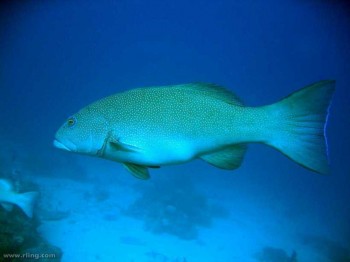Skin cancer identified in wild fish populations for first time

The coral trout, Plectropomus leopardus is the first wild fish in which skin cancer has been detected. © Richard Ling
A collaborative study between Newcastle University, England, and the Australian Institute of Marine Science published in the open access journal ‘PLoS ONE’ this week and has revealed the first recorded incidence of skin cancer in wild marine fishes.
The coral trout, Plectropomus leopardus, is a member of the family Serranidae and a commercially important food fish. It’s native to the Western pacific region and the diseased specimens were discovered at two localities within the Great Barrier Reef marine park off the coast of eastern Australia, directly beneath the largest hole in the planet’s ozone layer. Anecdotal evidence suggests minimal occurrence in other regions of the Great Barrier Reef and other coral trout species, but further research is required to confirm this.
The research team, led by Newcastle University’s Dr Michael Sweet, say the appearance of the melanoma is almost identical to that found in humans.
‘Further work needs to be carried out to establish the exact cause of the cancer but having eliminated other likely factors such as microbial pathogens and marine pollution, UV radiation appears to be the likely cause,’ explains Dr Sweet.
‘Studying disease in wild fish populations is very time-consuming and costly so it’s hard to say how long the disease has been around. However, what we do know is that it is now widespread in the coral trout population effecting three different species of this type of fish and we would not be surprised to find it in other species as well.’
Of the 136 fish sampled, 20 (15%) showed dark lesions on the skin – the lesions covered as little as 5% of the skin ranging to full coverage and an almost entirely black appearance. Dr Sweet said the numbers were significant.

Lesions were present on approximately 15% of the sampled population of Plectropomus leopardus; a) affected individual showingP. leopardus with almost complete coverage >90%; c) healthy tissue under light microscope and d) the lesion. © Sweet et al. 2012
‘The individuals we looked at had extensive – but only surface – melanomas,’ he explained. ‘This means the cancer had not spread any deeper than the skin so apart from the surface lesions the fish were basically healthy.
‘Once the cancer spreads further you would expect the fish to become quite sick, becoming less active and possibly feeding less, hence less likely to be caught. This suggests the actual percentage affected by the cancer is likely to be higher than observed in this study.’
UV-induced melanoma in fish has until now only been seen under laboratory conditions and has been used as a model to study the progress of human skin cancer due to the similarities in the disease.
In the lab, hybridised fish were found to be more susceptible to UV radiation due to exposure of the so-called ‘Xmrk’ gene. In the case of coral trout cross-breeding – or hybridisation – may also be occurring and play a role in the coral trout’s susceptibility to the disease.
Dr Michelle Heupel from the Australian Institute of Marine Science stated: ‘This is a crucial finding in an iconic and high value reef species.
‘Given climate change scenarios and continuing alteration of coral reef environments understanding the cause of this disease is important to continued conservation and management of reefs and their inhabitants.’
The study was funded by the Natural Environment Research Council (NERC), UK, and the Australian Research Council and the next step is to look at a much larger sample and determine the extent of disease presence and causation within the populations.
Source: Newcastle University (2012, August 1). Skin cancer identified for the first time in wild fish populations, beneath ozone layer hole.
Journal Reference:
- Sweet, M., N. Kirkham, M. Bendall, L. Currey, J. Bythell, M. Heupel. 2012. Evidence of Melanoma in Wild Marine Fish Populations. PLoS ONE 7(8): e41989 DOI: 10.1371/journal.pone.0041989
Category: Discoveries, Ichthyology, News | Tags: coral trout, fish cancer, Michael Sweet, Plectropomus | Comment »


Responsive design
Nice
13th Nov 2024
Responsive design
it is a complete malfunctioning horror on iphone and ipad.
10th Nov 2024
Major Changes in New World Cichlid Taxonomy
Reclassification of Genera: Several genera have been reclassified or merged. For example, the genus Cichlasoma has been split into multiple genera, an...
6th Nov 2024
Aphyosemion rectogoense
Many thanks cyprin, the image has now been removed.
31st Oct 2024
Product reviewers wanted
Hello! Very much interested in writing for you, please include me in the info. Thank you for the opportunity!
6th Sep 2020